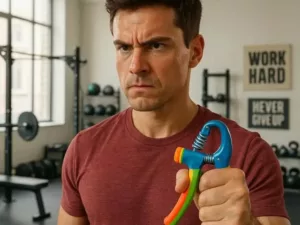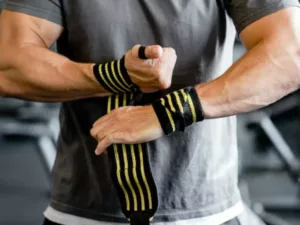(Last Updated on October 26, 2025 by Henry)
If you’ve never given much thought to your hand grip strength, you might be overlooking a key factor in your overall fitness, performance, and long-term health. Grip strength isn’t just about squeezing your fingers together; it represents your hands’ ability to grab, lift, pull, and control heavy loads with precision. This simple yet vital physical attribute has a ripple effect throughout your body, influencing everything from upper-body endurance to daily functional movements.
Through consistent hand grip exercises and strength training, you can build not only more powerful hands but also better forearm stability, improved muscle coordination, and stronger connective tissue. Grip training is one of those rare, foundational practices that benefit every athlete, from weightlifters to climbers, wrestlers, and even those recovering from injuries.
- Explore what grip strength truly means in practice
- Understand the basics of grip strength training and its importance in functional fitness
- Recognize the role of grip strength in performing everyday tasks and demanding physical exercises
- Learn about the connection between grip strength and neuromuscular activation for better muscle contractions
When it comes to neuromuscular activity and muscular coordination, your grip has a direct influence on the quality and power of your movements.
Picture yourself gripping a heavy barbell.
The moment your hands wrap tightly around the bar, motor neurons within your fingers, palms, and forearms instantly engage, sending powerful electrical signals throughout your nervous system.
The result? More efficient muscle recruitment, stronger contractions, and better overall control during your lift. This interaction between grip and muscle activation doesn’t just benefit professional athletes or gym enthusiasts; it plays a crucial role in daily life. From carrying groceries and opening jars to maintaining balance when you grab a railing, your grip strength keeps you grounded, steady, and safe.
It’s so important that researchers now consider grip strength a predictor of overall health and even longevity. A strong grip reflects functional muscle mass, metabolic efficiency, and the ability of your body to produce and sustain force safely.
Now that you understand the basic mechanics of grip training and why it matters, let’s take a deeper look at how improving your grip supports physical performance, prevents injuries, and enhances your overall health. From boosting athletic capability to supporting cardiovascular wellness, grip strength plays a far more important role than most people realize, and that’s where the story gets truly fascinating.
Benefits of Hand Grip Exercises: Improve Strength, Hand Health & Fitness
When you’re focused on achieving your fitness goals, it’s easy to underestimate just how vital grip strength truly is. Yet a strong and reliable grip can be your hidden advantage: not only when you’re lifting weights but across countless areas of overall health, mobility, and physical performance. It’s not all about building bigger arms or a stronger chest; your hands and forearms serve as the foundation for nearly every movement you perform in and out of the gym.
- Learn why developing grip strength is a powerful tool beyond the gym
- There’s a correlation between grip strength and cardiovascular health
- Insights from research on grip strength as a predictor of heart disease and mortality
Take cardiovascular health, for instance. We all know regular exercise supports a healthy heart, but did you know that hand grip strength has been directly linked to heart health as well? It might sound surprising, but the explanation is simple:
muscles act like engines that keep your blood circulating efficiently, and the stronger those muscles are, the better your cardiovascular system tends to perform.
Strengthening your hands and forearms through grip exercises indirectly supports your heart by improving overall muscle tone and circulation.

Research has shown that individuals with stronger grips often experience a lower risk of cardiovascular disease, reduced inflammation markers, and even decreased mortality rates related to heart conditions. That’s a powerful reason to add a few extra minutes of grip training into your workout routine, don’t you think?
But grip strength extends beyond heart health; it’s a reflection of your overall muscle condition and physical vitality. When we talk about muscle strength, we’re also referring to the very tissue responsible for your basal metabolic rate: how efficiently your body burns calories at rest. The more muscle mass you maintain, the higher your metabolism, and developing a stronger grip can subtly contribute to that by activating dozens of small stabilizing muscles in your hands, wrists, and forearms.

Crush Grip Training: Best Exercises & Tools for Stronger Hands

Pinch Grip Training: Proven Exercises & Tools to Boost Thumb Strength

Support Grip Training: Build Endurance & Lift Heavier Safely

Finger Extensor Training: Prevent Hand Pain & Build Balance

The 5 Primary Hand Movements: Gateways To Grip Strength

Train Your Wrists Like a Pro: Gain Strength, Mobility & Prevent Injury
So by incorporating consistent hand and forearm exercises, you’re not just improving strength, you’re also helping your body burn calories more efficiently and perform better in nearly every aspect of movement. It’s one of those simple yet overlooked fitness hacks that can deliver long-term benefits for both your performance and your overall health.
So why is grip strength so often ignored in workout routines? Perhaps because it feels too basic, something we take for granted in our daily lives. But this “fundamental” skill forms the bedrock of functional strength. Think about it: whether you’re pulling, carrying, climbing, or even typing for long periods, your hands are constantly at work.
That’s why developing strong, fatigue-resistant hands can make such a dramatic difference. In my experience, if you want to elevate your training results and unlock new levels of control and power, you should start with your grip. Improving your ability to clutch, hold, and sustain tension doesn’t just make you stronger in the gym: it prepares your body for the challenges of everyday life. Sometimes, the smallest muscle groups are the ones that hold the greatest potential.
Stronger Grip Strength for Heavier Lifts & Better Performance
I’m going to let you in on a little fitness secret: if you’re aiming to lift heavier weights, it’s not just about building up your arms or back; your grip strength plays a crucial role. A firm, stable grip gives you the control and confidence to manage any barbell, dumbbell, or pull-up bar effectively. When your hands can handle the load, your entire body can focus on power and precision rather than worrying about slipping or losing control. Let’s break down what this means for your training regimen and long-term strength progression.
When you dedicate time to grip strength training, you’re enhancing your body’s ability to handle heavier loads safely and efficiently. This simple adjustment in focus leads to better performance across all compound lifts. The stronger your grip, the more muscle fibers you recruit, and that’s the foundation of consistent muscle growth and performance improvement.

It’s not just about aesthetics or lifting heavier for bragging rights; grip strength directly contributes to overall functionality and injury prevention. A strong grip also supports your metabolism in ways that might surprise you.
Because your forearms and hands contain numerous small but highly active muscles, strengthening them helps improve muscle density and endurance, which contributes to a more robust metabolism and greater calorie burn even at rest.
In other words, better grip equals better efficiency, both in your workouts and your recovery.
In my experience, once you start focusing intentionally on your grip, you’ll notice the difference quickly, not just in your lifts but in your stability, coordination, and overall physical control. This isn’t just my observation; multiple studies have shown a clear connection between grip endurance and total lifting capacity. When your grip strength increases, the amount of compensatory effort required from the rest of your body decreases.
That means every lift becomes smoother, safer, and ultimately heavier over time. Your improved grip reduces energy leaks, allowing you to channel full force through your primary muscle groups, leading to more effective workouts and better long-term gains.
When choosing the right hand grip exercises, find something that resonates with your routine. Whether it’s squeezing a tennis ball, training with adjustable hand grippers, or using thick-bar tools to challenge your forearms, the key is consistency. Make it enjoyable and sustainable so that grip training naturally integrates into your weekly sessions.
Consistent, progressive grip training sets the foundation for noticeable improvements across every area of strength training. And remember, this is a long-term process: you don’t need to perfect it on the first try. Experiment, adjust your approach, and keep evolving your grip routine as your strength develops. The payoff? More power, better control, and a true sense of mastery every time you pick up a weight.
Lifelong Benefits of Grip Strength Training for Health, Function & Safety
You might not think about it often, but your grip strength impacts your quality of life in more ways than you realize, until it’s suddenly challenged. Imagine struggling to open a jar, carry a grocery bag, or hold onto a railing for support. These everyday movements rely heavily on the small but powerful muscles in your hands and forearms. And when those muscles weaken, the simplest tasks can quickly become frustrating.
Now, amplify that concept to something even more essential as we age, maintaining balance, mobility, and independence. That’s where grip strength training truly shines, serving as a long-term investment in your well-being and quality of life. Developing forearm strength and hand endurance doesn’t just make you stronger in the gym; it builds a foundation for stability and confidence in your daily movements.
As we get older, muscle strength and bone density play a key role in reducing the risk of injury.
A strong grip contributes directly to both, helping stabilize your body during slips, supporting posture, and even aiding in coordination.
In short, a functional grip helps you stay agile, capable, and independent well into later life, qualities that directly affect longevity and overall health.
But the benefits of grip strength go far beyond physical capacity. Research consistently shows that hand grip strength is positively associated with cognitive health.

Think about it: your brain is responsible for the fine motor control and coordination required for even the simplest grip movements. Strengthening these neural pathways through grip training can, over time, contribute to sharper coordination and mental resilience.
In fact, multiple studies highlight a clear connection between grip strength and reduced mortality risk, particularly in adults over 60. That doesn’t just translate to living longer: it means living better. People with stronger grips tend to experience fewer limitations in daily activities, greater mobility, and a higher degree of functional independence. Simply put, when your hands are strong, the rest of your body follows suit.
When you maintain a capable, conditioned grip, tasks that might otherwise seem daunting, like opening jars, carrying heavy bags, or even typing for long periods, become manageable. This physical confidence preserves your autonomy and, with it, your morale. Maintaining a powerful grip is about much more than strength; it’s about preserving freedom of movement, energy, and vitality as you age.
The best part? You don’t need an elaborate gym setup or complex fitness routine to start improving your grip. A few hand grip exercises incorporated into your daily or weekly routine can deliver profound benefits. Whether you’re using hand grippers, therapy balls, or even a towel twist drill at home, small, consistent actions can lead to significant improvements over time.
So if you’ve been overlooking your grip, now’s the perfect time to give it the attention it deserves. Next, let’s explore some of the most practical and effective grip exercises you can start using today to strengthen your hands, boost endurance, and future-proof your fitness.
Practical Hand Grip Exercises: Crush, Pinch & Support Grip Workouts
Choosing the right exercises is key to building a vice-like grip that supports both your athletic goals and your long-term hand health. The best part? You don’t need to spend hours on specialized equipment; these simple, practical hand grip exercises can make a noticeable difference in your overall strength, endurance, and control.
1Farmer’s Walk: Grab a pair of heavy dumbbells and walk for distance or time. This functional movement doesn’t just test your crush grip and support grip strength, it also improves posture, shoulder stability, and stamina.
If you’re looking for the right training tools for this kind of exercise, explore my “Lift It” category, which features sandbags, kettlebells, and dumbbells built for developing serious support grip.
2Static Holds: Static holds are as straightforward as they are effective. Grip a heavy barbell, plate, or pinch block and hold it until your grip starts to give out. Add them to the end of your workout to fully exhaust your forearms and thumbs.
For the best tools to build pinch and thumb strength, check out my “Pinch It” collection: specialized blocks and thick grip adaptors designed to target the hardest-working parts of your hands.
3Dead Hangs: Hanging from a pull-up bar might seem easy, but it’s one of the best ways to build endurance and control through your forearms, hands, and fingers. Aim to increase your hang time each week or add resistance for more challenge.
If you’re into climbing, calisthenics, or static grip training, visit my “Climb It” category for bars, climbing boards, and finger loops made for high-level grip training.
4Wrist Curls: Using a barbell or dumbbell, perform wrist curls to strengthen your forearm flexors and extensors: key muscles for overall grip performance. For a more rotational approach, wrist rollers are a game changer.
You’ll find a full range of them in our “Twist It” hub, where you can explore tools designed to enhance wrist control, endurance, and stability.
5Grip Squeezers: Portable, compact, and endlessly effective, grip squeezers can go wherever you do. Whether you prefer heavy-duty spring grippers or softer therapy-style balls, these tools target your crush grip and hand endurance directly.
You can find the best options in our “Crush It” category, featuring adjustable grippers, silicone balls, and more to help you build raw squeeze power.
You don’t need to overhaul your entire routine to reap the benefits of these grip exercises. Simply incorporating them two to three times a week can lead to major improvements in both strength and control.

Modern Rice Bucket Gadget for Grip & Forearm Training?
Remember, your grip is the foundation of your physical performance, whether you’re lifting weights, climbing, or performing everyday tasks. Investing time in grip strength training not only enhances your workout performance but also builds functional power that benefits you for life.
Building a strong, functional grip doesn’t have to be complicated. By combining different types of exercises and using the right tools, you can develop all aspects of hand strength: support grip, pinch grip, crush grip, and wrist control. Start with lifting tools like dumbbells and sandbags to build overall support grip.
Add pinch-focused exercises to strengthen your thumbs and fingers. Don’t forget to challenge yourself with dead hangs and climbing tools to improve endurance and static grip. Incorporate wrist rollers and rotational tools to protect your joints and boost wrist power. Finally, spring grippers and therapy balls can help you maximize crush grip strength and improve finger tendon health.
By exploring all five hand movements and integrating them into your routine, you create a balanced, comprehensive grip training plan that not only enhances athletic performance but also supports hand health and functionality for everyday life. This holistic approach ensures that every part of your grip is strong, resilient, and ready for whatever challenges you face: whether in the gym or in daily activities.
Thanks for Stopping By
Have Questions?
Please Leave A Comment






